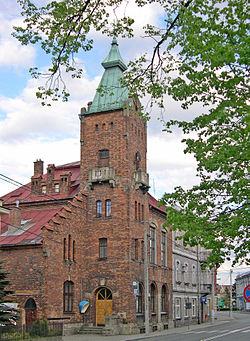Brzesko
Brzesko | ||
|---|---|---|
 Town Hall | ||
|
Car plates KBR | | |
| Highways | ||
| National roads | ||
| Voivodeship roads | ||
| Website | http://www.brzesko.pl | |
Brzesko (
As of December 2021, the town has a population of 16,665.[1] Historically, the town was subject of various ownerships since its 1385 founding. Okocim Brewery, founded by Jan Goetz in 1845, is located in nearby Okocim (3 km (1.9 mi)).
Brzesko lies on the Uszwica river, along the important rail route from Kraków to Przemyśl, and along the European route E40. The town has a 14th-century church of St. Jacob, and the 19th-century palace of the Goetz family (founders of the Okocim Brewery). Other historic buildings were either destroyed in numerous wars, or burned in fires, such as the great fire of 1904. The name Brzesko probably comes from the word brzeg (shore), as the town is located on the shore of a river.
History

The town was founded in 1385 by Spytko II of Melsztyn, the castellan of Biecz, with permission of Queen Jadwiga of Poland. Brzesko still retains the medieval shape of its town center, with a market square and the Gothic church of St. Jacob (1447).
In 1440, the town built a hospital for the poor, funded by
During the German invasion of Poland, which started World War II, the Wehrmacht arrived in Brzesko on 5 September 1939.[2] Soon afterwards, the Einsatzgruppe I entered the town to commit various atrocities against the populace.[3] Under German occupation, the town became part of the kreis (county) Tarnów in the Kraków District of the General Government, a separate administrative region of the Third Reich. 44 people were killed and about 200 were injured as they were waiting for the evacuation trains from Silesia.[4] Several Poles from Brzesko were murdered by the Russians in the large Katyn massacre carried out in April–May 1940.[5] A closed Jewish ghetto existed between spring 1941 and September 1942.[2] It spread across 3 areas: Berka Joselewicza Street, then all the buildings north of the Market Square up to the Rynek Sienny (known today as Sobieskiego Street and Chopina Street), and finally Głowackiego Street up to Trzcianka and the Kazimierza Wielkiego Square.[6] Several Poles were imprisoned by the Germans in the local prison and then deported to concentration camps for rescuing Jews.[7] The Red Army arrived in Brzesko on 19 January 1945,[4] and then the town was restored to Poland.
Historical cemeteries

The town has several cemeteries of historical significance. There are three military cemeteries dating from
The three military cemeteries were all commissioned by the
The "New Jewish Cemetery" was originally thought to have been built and replaced the "Old Jewish Cemetery" in 1846, when the latter became full. However, more recent research carried out by the Museum of
Sports
Brzesko is home to
Points of interest


In addition to its historical cemeteries points of cultural interest in Brzesko include the
People
- Leszek Lubicz-Nycz (1899-1939), Polish fencer
- Mala Zimetbaum (1918-1944), Resistance fighter in World War II
- Jolanta Ogar-Hill (b. 1982), Polish sailor
See also
References
- ^ a b "Local Data Bank". Statistics Poland. Retrieved 2 June 2022. Data for territorial unit 1202024.
- ^ a b "History | Virtual Shtetl". sztetl.org.pl. Retrieved 30 March 2020.
- ^ Wardzyńska, Maria (2009). Był rok 1939. Operacja niemieckiej policji bezpieczeństwa w Polsce. Intelligenzaktion (in Polish). Warszawa: IPN. p. 58.
- ^ a b "Historia Miasta". Retrieved 31 March 2020.
- ISSN 1232-5678.
- ^ "Getto w Brzesku | Wirtualny Sztetl". sztetl.org.pl. Retrieved 31 March 2020.
- ^ Rejestr faktów represji na obywatelach polskich za pomoc ludności żydowskiej w okresie II wojny światowej (in Polish). Warszawa: IPN. 2014. p. 264.
- ^ "Nowy cmentarz przy ul. Czarnowiejskiej - Cmentarze - Zabytki - Brzesko - Wirtualny Sztetl". Sztetl.org.pl. Retrieved 19 June 2012.
- ^ "Robert Kozłowski" (in Polish). Cmentarze.gorlice.net.pl. Retrieved 19 June 2012.
- ^ "Starostwo powiatowe w Brzesku". Brzeski.nazwa.pl. Archived from the original on 24 October 2013. Retrieved 19 June 2012.
External links
- Official town website
- Jewish Community in Brzesko on Virtual Shtetl

